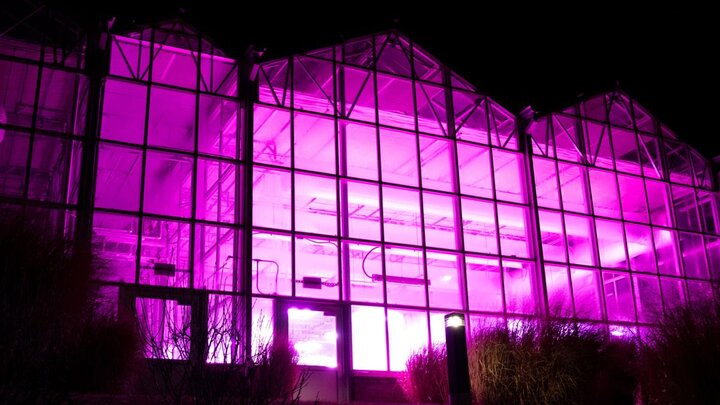Curious Cornhuskers: Why the Innovation Campus greenhouse lights are pink at night

As part of our initiative called Curious Cornhuskers, an anonymous reader asked The Daily Nebraskan, “Why are the Innovation Campus’s greenhouse lights pink at night?”
The lights give off a pink or purple color because they are a mixture of the red and blue colors that plants like to absorb, according to Amy Hilske, plant growth facilities director for the Greenhouse Innovation Center on Nebraska Innovation Campus. She said the greenhouse’s lights are programmed to be 20% blue and 80% red because of research that shows plants absorb red more.
The color can be adjusted depending on a plant’s needs, and Nathan Duffy, research technologist at the greenhouse, said the lights can be raised and lowered depending on the plant’s height.
LED lights, light-emitting diodes, are a new technology in greenhouses, Duffy said.
“It makes the lights more efficient,” he said. “Really, what we’re going for [is] energy efficiency and using the exact light the plants need, so that we’re not wasting energy in that regard.”
The amount of time the lights remain on depends on the crop, Hilske said.
“Some crops really like 16 hours of light, and right now with the sun, it’s only about 12 hours,” she said. “We use the lights to extend the day, essentially tricking the plants into thinking it’s still daytime.”
The Innovation Campus greenhouse is used for plant phenotyping, or taking pictures of the plants for researchers who rent space in the greenhouse, Hilske said.
Most of the research done in the greenhouse is climate-based, according to Duffy, including drought and nutrition projects. He said they are able to control the temperature in the greenhouses, and they monitor how plants react to different temperatures.
Hilske said greenhouse employees grow the plants for researchers, and the researchers can have the employees care for the plants for a higher rate. Professors that rent space in the greenhouse usually have graduate students with their own staff of student workers who take care of the plants, she said.
Along with renting out space, Hilske said the greenhouse is used to grow plants for classes.
“We’re involved with probably [3,000] to 4,000 students a year,” she said. “We either grow plants for botany lab classes — those kinds of things. There [are] a lot of faculty members who teach and have projects in some of our teaching greenhouses.”
Duffy said everything in the greenhouse is there to make the operation more energy efficient, from temperature control to the LED lights.
“Instead of wasting the greens, the yellows, the oranges, we’re just putting on the light the plant wants,” he said. “It’s all about efficiency.”
By: Jolie Peal, The Daily Nebraskan
